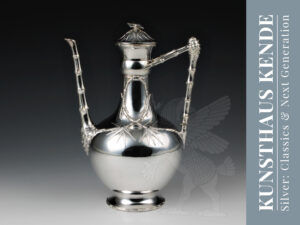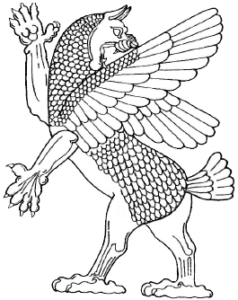Item number: 58352
A rare 950 silver Aesthetic Movement coffee pot,
Paris circa 1880 by Elvire Queillé
The subtly rounded and smooth body standing on a flat base with a bamboo rim, the front and back of the body decorated with crossed bamboo branches, the top terminated with a corresponding lid with bamboo leaf decoration and a branch segment as a knob. The silver handle on the back made in the shape of a naturalistic bamboo branch which divides into two smaller branches to the upper sockets and being connected to the body heat stoppers made of bone. The spout, like the handle, is also formed as a bamboo branch.
Exceptional Art Nouveau coffee pot in 950 silver in the rare Aesthetic Style that was en vogue for a short time during the Art Nouveau.
19.1 cm / 7.51″ length, circa 13.8 cm / 5.43″ diameter, circa 26.4 cm / 10.39″ tall; 940.8 g / 30.24 oz
The correlation of Japanese art to the works of Art Nouveau and Arts & Crafts
The affinity of Art Nouveau with Japanese art was based in particular on the designs of British artists of the Aesthetic Movement as well as on the silverware of Tiffany, which was first introduced in 1875 whose works in silver and mixed metal (silver combined with bronze or brass) promoted interest in Japanese art. In France and the French-speaking countries in particular, there was a great interest in Japanese stylistic tendencies during the Art Nouveau period, which was due to the increased circulation of Japanese prints and items of everyday´s use that were brought through the trade in Europe from 1860 onwards.
The Queillé silversmith dynasty
Elvire Queillé (1834-1896) is documented as a silversmith from 1874 to 1895 and came from an old, respected silversmithing dynasty founded by Pierre-François Queillé I, a silversmith specialising in cutlery, in 1808 in the Marais district of Paris. In honour of the founder, the silversmiths had kept their master mark until the end. The silversmith’s workshop was purely family-owned until 1895, when a share of the workshop was acquired by the silversmiths of Henry Laparra. The other part of the workshop remained in the hands of Emile Queillé until he died in 1955.





